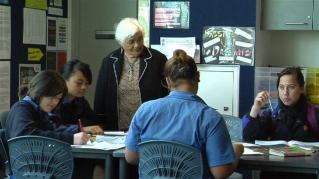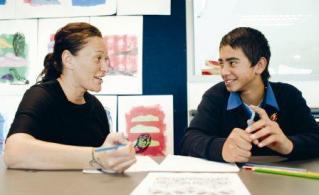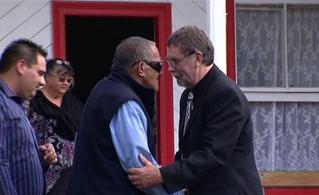Section navigation
The Chisnallwood Intermediate case study is part of the Te Kauhua case studies report (2010), prepared for the Ministry of Education by Dr Ruth Gorinski. As part of their action research for Te Kauhua phase 3, Chisnallwood Intermediate investigated the ways that the provision of a culturally connected learning context facilitates Māori student and whānau engagement in learning and teaching.
Background
Chisnallwood Intermediate School (CIS) is a decile five, urban Christchurch with a roll of 822 students, 17% who identify as Māori. The school has been involved in the Te Kauhua initiative since its inception in 2006.
Research Question
In what ways does the provision of a culturally connected learning context facilitate Māori student and whānau engagement in learning and teaching?
Impetus for the initiative
The impetus for this initiative was two-fold: one, based on whānau and teachers’ aspirations; the other on student expressed desires. The initiative enabled teachers to facilitate opportunities for Māori students to increase knowledge of their ethnicity (cultural learning), and also provided an opportunity for whānau to contribute to their tamariki’s (children’s) education.
For some time, the whānau of Māori students at CI had expressed a desire to better support their tamariki in their learning. They said for example: “I didn’t do very well at school and I don’t understand the new maths. I’m worried that I will teach them it all wrong.” Whānau wanted to help but felt that they did not possess, or have access, to appropriate skills or knowledge. Their low attendance at whānau hui and parent teacher interviews was symptomatic of the lack of equity in terms of whānau as contributing partners in the learning community. Teachers raised concern about a somewhat ‘faceless’ Māori community and their desire to connect with whānau and have conversations about Māori student’s achievement and successes.
During face to face interviews, students expressed a desire for increased opportunities to learn about themselves, their ethnicity and their language. They articulated their feelings of inadequacy to participate in a culturally connected environment. Many Māori students spoke of their feelings of cultural isolation as learners. They said for example: “if I can work with someone else I just work better, we can do it together and I do it better.” Students expressed a desire for increased opportunities to work in small groups. They did not wish to be the only Māori student within a group.
What was done
In an endeavour to meet expressed teacher, whānau and student needs, CI staff decided to focus their action research on the development of a culturally connected learning context based around whakapapa. The vision was that students would have in-depth conversations with whānau which would reinforce their identity through linking their past to the present. It was anticipated that students would be able to make connections with one another - both Māori and Pakeha - through their shared oral and visual histories.
The whakapapa initiative was a schoolwide initiative involving over 30 teachers and 817 students (137 Maori). In addition, specialist teachers in art, ICT and wood technology were involved.
All teachers were given a copy of a proposed action plan (Appendix 2) to discuss at a syndicate level. The expected learning outcome was that students would present their whakapapa orally and visually. In preparing for this, students were required to interview members of their whānau. The aim was for teachers to modify the action plan for their class needs, using the key processes as a guide for ensuring the intended outcomes were met. These outcomes included:
- Engaging students in a culturally connected learning context.
- Involving whānau in student learning.
- Providing an opportunity for family to comment on their child’s learning.
- Planning a celebration of student learning.
All teachers incorporated the initiative in their classroom programme. The depth of learning was somewhat dependent on the skill base within the varying syndicates and access to resources, including human resources.
With the exception of two students, with the support of whanau and extended whānau, all tamariki returned their learning intention task sheet signed and completed by a parent and they prepared their oral and visual mihi. Teachers also completed their own whakapapa presentations. All teachers observed what became commonly referred to as the ‘buzz’ associated with student engagement/motivation linked to this initiative. Students articulated their newly discovered whakapapa connections not only to place and famous New Zealanders, but also to each other and staff. In this way the culturally connected learning context for the research enabled students to explore their culture and connect the classroom - a place of learning - to the knowledge and practices valued by Māori, both past and present. Teacher and whānau resources (Appendix 4) supported students in their learning.
What was the impact on student learning and achievement?
Teachers commented on the success of the learning celebrations, stating that they had never experienced such a high level of participation and attendance by whānau and in many cases extended whānau at previous school events. Students were excited to share not only the work associated with this initiative but other examples of their work with family members. Students were proud to introduce their whānau and for many it was the first face to face (kanohi ki te kanohi) exchange teachers and whānau had experienced in the current year.
There was a shift in the power balance, whānau moving from being informed consumers to demanding constituents in their child’s learning. Whānau offered to help with class trips, sewing bees for the kapahaka uniforms and expressed a desire to be part of the focus group that the school has established for regular networking purposes with the Māori community. In addition, parents now ask teachers for suggestions on how they can better support their child’s learning in the home.
For many teachers, this was their first real experience of the theory that culture counts. The walls that isolate teachers from the community and students from their whānau, were disassembled as teachers opened themselves to whānau input on how to engage students and develop partnerships.
The data gleaned from the research revealed that students, teachers and whānau benefited. The following data summarises these data.
Students
- Student voice captured and used to develop further programmes.
- Increased engagement during classroom lessons.
- Increased sense of identity and belonging.
- Increase in self esteem.
- Improved classroom relationships.
Teachers
- Baseline data collected to inform programme development.
- Increased understanding of Māori students.
- Use of community resources to enhance programmes.
- Improved classroom relationships.
- Teacher self-efficacy enhanced.
- Improved staff pronunciation in te reo Māori.
Whānau
- Whānau voice captured and used to develop further programmes.
- Increased whānau participation in student learning.
Key learning
- The development of a culturally responsive, localised curriculum is a pre-requisite to an effective education for Māori learners.
- Student voice is key to ensuring that teaching and learning opportunities are useful and valued by learners.
- Syndicate level planning that involves learners is important in ensuring students’ prior knowledge is scaffolded.
- Teacher role playing of responses to challenging cultural questions/issues alleviates anxiety.
- A culturally contextualised curriculum significantly increases the range and number of conversations amongst teachers, whānau and learners.
- ICT and art facilitate storytelling, personalised learning and collaboration amongst teachers, whānau and learners.
Challenges and opportunities
- Teacher anxiety about a lack of local tikanga knowledge, te reo Māori competence and/or understanding of how to construct a culturally contextualised teaching and learning programme.
- Teacher perceptions of whānau apathy towards classroom and school based activities.
- Lack of parental support for a culturally contextualised curriculum.
Reflective questions
- What context could we as a school utilise, to develop a culturally connected learning environment?
- How could we involve whānau and iwi in this?
- How could I work with my class to provide opportunities for Māori students to learn about their culture and language?
- How as a school, can develop increased competence in te reo and tikanga Māori?
Filed under: Productive partnerships | Effective teachers





